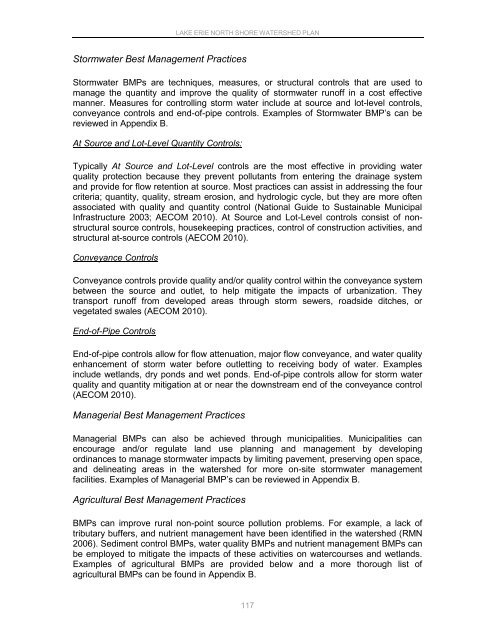Lake Erie North Shore Watershed Plan - Niagara Peninsula ...
Lake Erie North Shore Watershed Plan - Niagara Peninsula ...
Lake Erie North Shore Watershed Plan - Niagara Peninsula ...
Create successful ePaper yourself
Turn your PDF publications into a flip-book with our unique Google optimized e-Paper software.
LAKE ERIE NORTH SHORE WATERSHED PLAN<br />
Stormwater Best Management Practices<br />
Stormwater BMPs are techniques, measures, or structural controls that are used to<br />
manage the quantity and improve the quality of stormwater runoff in a cost effective<br />
manner. Measures for controlling storm water include at source and lot-level controls,<br />
conveyance controls and end-of-pipe controls. Examples of Stormwater BMP‟s can be<br />
reviewed in Appendix B.<br />
At Source and Lot-Level Quantity Controls:<br />
Typically At Source and Lot-Level controls are the most effective in providing water<br />
quality protection because they prevent pollutants from entering the drainage system<br />
and provide for flow retention at source. Most practices can assist in addressing the four<br />
criteria; quantity, quality, stream erosion, and hydrologic cycle, but they are more often<br />
associated with quality and quantity control (National Guide to Sustainable Municipal<br />
Infrastructure 2003; AECOM 2010). At Source and Lot-Level controls consist of nonstructural<br />
source controls, housekeeping practices, control of construction activities, and<br />
structural at-source controls (AECOM 2010).<br />
Conveyance Controls<br />
Conveyance controls provide quality and/or quality control within the conveyance system<br />
between the source and outlet, to help mitigate the impacts of urbanization. They<br />
transport runoff from developed areas through storm sewers, roadside ditches, or<br />
vegetated swales (AECOM 2010).<br />
End-of-Pipe Controls<br />
End-of-pipe controls allow for flow attenuation, major flow conveyance, and water quality<br />
enhancement of storm water before outletting to receiving body of water. Examples<br />
include wetlands, dry ponds and wet ponds. End-of-pipe controls allow for storm water<br />
quality and quantity mitigation at or near the downstream end of the conveyance control<br />
(AECOM 2010).<br />
Managerial Best Management Practices<br />
Managerial BMPs can also be achieved through municipalities. Municipalities can<br />
encourage and/or regulate land use planning and management by developing<br />
ordinances to manage stormwater impacts by limiting pavement, preserving open space,<br />
and delineating areas in the watershed for more on-site stormwater management<br />
facilities. Examples of Managerial BMP‟s can be reviewed in Appendix B.<br />
Agricultural Best Management Practices<br />
BMPs can improve rural non-point source pollution problems. For example, a lack of<br />
tributary buffers, and nutrient management have been identified in the watershed (RMN<br />
2006). Sediment control BMPs, water quality BMPs and nutrient management BMPs can<br />
be employed to mitigate the impacts of these activities on watercourses and wetlands.<br />
Examples of agricultural BMPs are provided below and a more thorough list of<br />
agricultural BMPs can be found in Appendix B.<br />
117
















